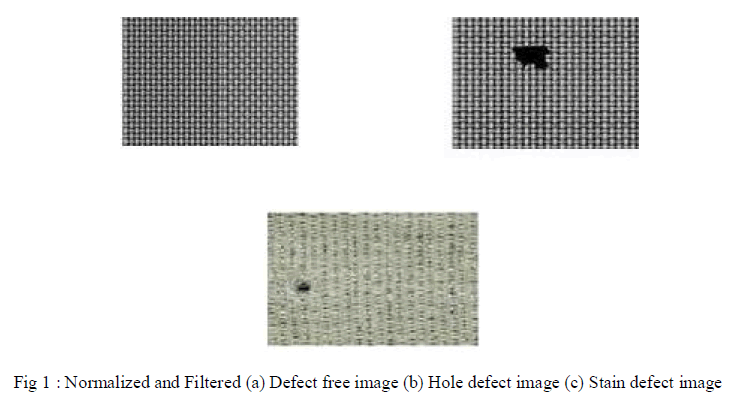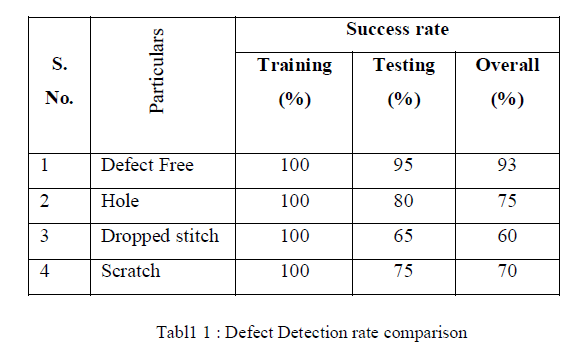ISSN ONLINE(2320-9801) PRINT (2320-9798)
ISSN ONLINE(2320-9801) PRINT (2320-9798)
Dr. G. M. Nasira1 , P.Banumathi2
|
| Related article at Pubmed, Scholar Google |
Visit for more related articles at International Journal of Innovative Research in Computer and Communication Engineering
Textile industry is one of the main sources of revenue-generated industry. The price of fabrics is severely affected by the defects of fabrics that represent a major threat to the textile industry. A very small percentage of defects are detected by the manual inspection even with highly trained inspectors which is time consuming and not accurate enough. An automatic defect detection system can increase the defect detection percentage; it reduces the fabrication cost and economically profitable when we consider the labour cost and associated benefits. In this paper we have proposed a method to detect the defects in woven fabric. The images are acquired, pre-processed and normalized then a structural feature is extracted. The Artificial Neural Network is used as defect identification model. The extracted features are given as input to the artificial neural network, it identifies the defect. The proposed method compare with relevant recently reported works and shows a better performance which is to be very promising.
Keywords |
| Artificial Neural Networks(ANN), Back Propagation Algorithm, Defect Identification, Feature Extraction, Image Processing |
INTRODUCTION |
| The textile industry of Tamil Nadu has been the major revenue creation sector. Textile processes are costly in terms of money, time and consumer satisfaction due to inefficiency. The business of textile industry becomes more competitive. Textile industry should improve the quality of the production process in order increase current level of performance in the global market. Early and accurate identification of defects is an important aspect of quality improvement. Due to fatigue and tiredness, the accuracy of manual inspection is not good enough. The solution to this problem is automated defect identification system. Feature selection plays an important role in developing automated fabric identification system. For an appropriate feature set, the number of features should be small and the quality of the feature should be high. |
| One of the important aspects of textile fabrics is quality. For maintain the quality of fabric automated inspection system is highly needed by the textile industry. Finding the location of defects and determining the type of defect are also important. The advantage is to get a warning when defect or imperfection occurs during the production of the fabric, so that some precautionary measures can be taken before the product goes for inspection. Fabric defect detection has been a long – felt need in the textile and apparel industry. Surveys carried out in the early 1975 shows that inadequate or inaccurate inspection of fabrics has led to fabric defects being missed out, which in turn had great effects on the quality and subsequent costs of the fabric finishing and garment manufacturing processes. |
| It has been observed [4] that price of textile fabric is reduced by 45% to 65% due to defects. Manual defect detection in a fabric quality control system is a difficult task to be performed by inspectors. The work of an observer is very tedious and time consuming. They have to detect small details that can be located in a wide area that is moving through their visual field. The identification rate is only about 70% [5]. Moreover, the effectiveness of visual inspection decreases quickly with fatigue. Digital image processing techniques have been increasingly applied to textured sample analysis over the past several years. Wastage reduction through accurate and early stage detection of defects in fabrics is also an important aspect of quality improvement. The high cost, along with other disadvantages of human visual inspection has led to the development of automated defect inspection systems that are capable of performing inspection tasks automatically. The problem of textile web inspection is particularly complex, since there is a large variety of fabrics of different structures, compositions, colours, and other properties. |
| Human inspection systems are still preferred for a number of tasks because an alternate solution, reliable and versatile enough, is not available yet. Therefore, the search in the field is still wide open. Several techniques of image analysis have been proposed for this purpose. Inspection of 100% of fabric is necessary (1) to determine the quality and (2) to detect any disturbance in the weaving process to prevent defects from reoccurring. Performance and assessment is never constant and effectiveness decreases quickly with fatigue. Owing to the very slow speed of human visual inspection compared to production rate, automatic inspection is more important than ever. Many researchers have worked on the automation of inspection systems. |
| Fabric texture refers to the feel of the fabric [3]. It is smooth, rough, soft, velvety, silky, lustrous, and so on. The different textures of the fabric depend upon the types of weaves used. Textures are given to all types of fabrics, cotton, silk, wool, leather etc., In textile, different types of faults are available i.e. hole, scratch, stretch, fly yarn, dirty spot, slub, cracked point, colour bleeding etc; if not detected properly these faults can affect the production process massively. The objective of the proposed work is to identify whether the fabric is defective or not. |
II. RELATED WORK |
| Digital image processing plays a vital role in Fabric defect detection for the past decades and numerous approaches have been proposed. R.K. Rao [3] found that introducing principal component. Wang et a1. [4] found that by using thresholding techniques 90% of the defects in a plain fabric could be detected. Zhang et al. [5] have introduced two approaches to detect defects: gray-level statistical and morphological methods. Lanes [8] has defined a number of convolution masks to detect the defect. These methods depend on intensity change on the fabric image, can only capture significant defects such as knot, web, and slub. Fourier transform based approaches were developed for defect detection by some researchers. Wood [9] has used Fourier and associate transform to characterize carpet patterns, while in [10], the approach used is Histogram equalization followed by FFT and central spatial frequency spectrum analysis. Most of the algorithms used today for fabric defect detection are computationally intensive and are less accurate. The proposed algorithm is simple and more efficient for implementation. There is no mathematical complexity as in other methods and hence there is a significant improvement in computational time also. Ma Hong Long, [11] introduced defect detection using fourier spectrum. Lu Yun, Zhang Jingmiao, [12] introduced defect detection based on image distance differ. |
III. PROPOSED ALGORITHM |
A. Description of the Proposed Algorithm: |
| The most important parameter used in the image acquisition is the resolution. Either the size of one pixel or the number of pixels per inch can refer the resolution of an image. The lower the image resolution, the less information is saved and higher resolution means more information is saved but larger memory size is required to store. The scanning of fabric images begins from 300 dpi resolution because human vision is approximately 300 dpi at maximum contrast. The scanned image is stored in ‘tif’ format and grayscale image. A flat scanner is used to capture various plain fabric samples containing different types of defects. Initially the resolution level is set to 300 dpi and then gradually increased by step of 100 dpi till 1200 dpi as a maximum resolution. The images are stored in matrices of size 500x500 pixels. |
| The acquired image may contain noise; noise is the result of errors in the image acquisition that result in pixel values. Noise reduction is the process of removing noise from the image by using noise-removing techniques. Mean or Averaging filter is best for removing noise. In averaging filter, replace each pixel by the average of pixels in a square window surrounding this pixel. Larger window can remove noise more effectively but also blur the details/edges. |
| The filtered image is converted into binary image, then the area of binary image is calculated.Image enhancement is the next step in image pre processing. By using this technique, highlight certain features of interest in an image. The histogram of an image is drawn by using imhist function. |
| The feature area is extracted from the binary image. The extracted feature is given as input of Artificial Neural Network, which is fault identifier. |
| Step 1: Image acquisition using Digital Camera. |
| Step 2: Image preprocessing techniques applied for the acquired image. |
| Step 3: The filtered image is normalized then filtered using adaptive median filtering. |
| Step 4:The area value is calculated and taking area values as threholding the filtered image in converted into binary image. |
| Step 5 :If area value is less than particular value then the image is defect, if not the image is normal. |
IV. PSEUDO CODE |
| Step 1: Read the image. |
| Step 2: The image is preprocessed and normalized using interpolation techniques. |
| Step 3: The image is converted into binary image. |
| Step 4: Area is calculated by using number of connected components in the image. |
| Step 5: Based on the area value the image is converted into binary image. |
| Step 6: Display the result. |
| Step 7: End. |
V. SIMULATION RESULTS |
| In this paper, the supervised backpropagation neural network classifier is used for fabric defect detection Backpropagation uses gradient descent algorithm. Backpropagation learning updates the network weights and biases in the direction in which the performance function decreases ie. the negative gradient. function. |
| where xk is a vector of weights and biases, k is the learning rate and gk is the current gradient. The gradient descent algorithm can be implemented in two modes. They are incremental mode and batch mode. In incremental mode the gradient is computed and the weights are updated after each input is applied to the network. In batch mode all the inputs are applied to the network before the weights are updated. The gradient descent training function is used to train the network. There are seven training parameters are used to train the network. The learning rate is too small, the algorithm takes a long time to converge. If the learning rate is too large, the algorithm becomes unstable. |
| The performance of the proposed fabric defect detection model is evaluated by using a set of 30 different fabric images chosen from the manual of fabric defects in the textile Industry. There are 20 defect free and 10 different types of defective images chosen. |
| In this paper, we considered four types of defects images and all the images have a size of 256x256 pixels and an 8-bit gray level. There are 30 defective and non-defective images used for training and 15 images used for testing. The BPN classifier is used to detect and classify the defects. |
 |
 |
VI. CONCLUSION AND FUTURE WORK |
| In this paper, a new fabric defect detection system based on BPN identifier was presented. The recognizer acquires digital fabric images by image acquisition device, preprocesses, and normalizes the image. The image is filtered or noise removal by using adaptive median filtering techniques into binary image by restoration and threshold techniques. The features are extracted from the pre processed image. The extracted features are input to the BPN classifier for further matching process. We achieved the success rate of 93% . The experiment result shows that the proposed method is feasible in textile production factories for defect detection and classification. |